|
|
Some articles have not been moved to our new site yet.
As a result you have been redirected to our old site.
If you wish to return to our new site - click here.
Cannabis
use in Britain
|
|
Matthew
J. Atha BSc MSc LL.B - Director - IDMU Ltd
|
1. Introduction
1.1 These
lecture notes are intended as an introduction to Cannabis
use in the UK. These briefly cover prevalence of cannabis
use among different age groups, consumption patterns,
initiation to drug use (the "progression"
theory), the types of cannabis available, methods
of use, driving, medicinal use and possible future
policy options.
1.2 Cannabis
is the most widely-used illegal drug on the planet,
and has been one of the most intensively-studied substances
of all time. It is also the drug which causes the
most controversy, and arouses the strongest emotions
on both sides. The legalisation argument has been
creeping steadily up the political agenda in recent
years, with the opinion polls, once 6 to one against
reform, now showing public opinion to be evenly divided
between the reformers and prohibitionists.
1.3 The
purpose of this lecture is to shed light where there
is darkness, and critically analyse some of the misinformation,
myths and half-truths on both sides of the argument.
1.4 This
document presents some of our own research data, mostly
in graphic or tabular form, and much of it for the
first time. Commentary is generally kept to a minimum.
2. Prevalence of Cannabis Use
2.1 The
Home Office conducts the British Crime Survey every
2 years, including questions on whether people have
ever used a range of drugs, and if so whether they
have done so in the past year or past month. The prevalence
of cannabis use has been rising in these surveys since
they were first conducted in the early 1980s. In the
UK, around 15 million people would now admit having
tried cannabis, with between 2 and 5 million regular
users.
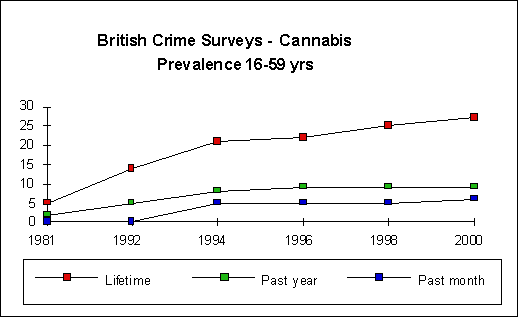
2.2 Cannabis
use is highest in the 16-29 age group, although the
rise in use is sharpest among older adults. Part of
this is demographic, as existing or former users progress
into the older age groups, although first time use
among elderly citizens, particularly for medicinal
reasons, is becoming more common.
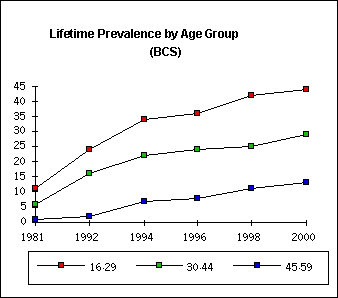
2.3 IDMU
Surveys - Our research is based primarily on our
drug user surveys, which have been conducted in 1994,
and in each year since 1997, as well as my own 1984
survey which pioneered the methodology. Respondents
are asked to complete anonymous questionnaires, containing
a number of core variables, with other questions varying
from year to year. Surveys have been distributed primarily
at pop-festivals and pro-cannabis rallies, although
smaller batches have been distributed via subcultural
magazines, snowballing, via direct mailings to members
of pressure groups, and at other events. Development
has been evolutionary, and response rates have been
increased via use of our own stalls and provision
of clip-boards at outdoor events.
2.4 The
age range of respondents would appear to be broadly
representative of regular cannabis users in the UK
population, with the majority falling in the 18-30
age range.
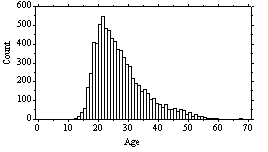
Cannabis
Convictions 1945-1999
(Linear Scale)
(includes
Cautions and all formal disposals)
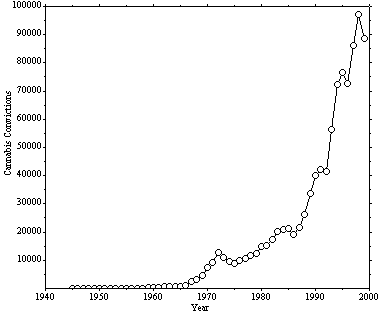
2.5 The Home Office publishes
annual statistics on drug seizures and drugs offenders.
These have been rising steadily since the end of World
War II, the millionth conviction would have occurred
around December 1999. Dangerous Drugs Acts 1945-1972
= 44,834, Misuse of Drugs Act 1973-1999 = 958,688,
Total - 1,003,522
Cannabis Convictions 1945-1999 (Logarithmic
scale)
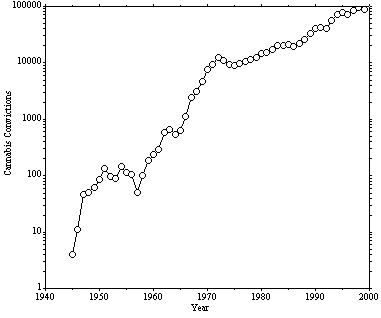
3. Frequencies of Cannabis Use
|
Frequency of Cannabis Use 1984-2000
|
|
Year
|
1984
|
1994
|
1995
|
1997
|
1998
|
1999
|
2000
|
84-00n
|
84-00%
|
|
Non/ex-users
|
2.5%
|
5.3%
|
9.4%
|
10.8%
|
11.8%
|
5.4%
|
5.5%
|
524
|
7.1%
|
|
Experimental
|
0.0%
|
2.6%
|
2.6%
|
2.5%
|
2.4%
|
3.8%
|
4.3%
|
215
|
2.9%
|
|
Occasional
|
11.2%
|
16.6%
|
2.1%
|
16.6%
|
18.5%
|
19.8%
|
21.6%
|
1303
|
17.7%
|
|
Weekly
|
31.8%
|
20.5%
|
29.8%
|
20.0%
|
18.3%
|
20.2%
|
20.4%
|
1560
|
21.2%
|
|
Daily
|
53.5%
|
55.0%
|
56.0%
|
50.1%
|
49.0%
|
50.8%
|
48.1%
|
3766
|
51.1%
|
3.1 The
majority of users in our surveys smoked cannabis regularly,
with the usage pattern more similar to that for tobacco
and for caffeine than for other illicit drugs. The
survey population would thus be broadly equivalent
to the "used in past month"
4 Amounts used
|
Cannabis Use/Ratings by year
|
|
Subject
|
1984
|
1994
|
1995
|
1997
|
1998
|
1999
|
2000
|
|
Subjective rating (0-10)
|
n/a
|
8.8
|
8.5
|
8.8
|
8.4
|
8.3
|
8.4
|
|
Mean used per month
|
29.3g
|
24.8g
|
31.3g
|
23.9g
|
20.7g
|
26.9g
|
31.6g
|
Distribution
of monthly cannabis use (94-00)
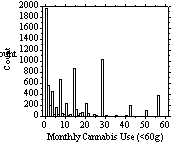 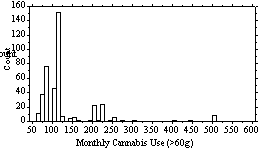
4.1 The
majority of users smoke relatively small amounts of
the drug, with mean consumption of 1g per day. Progressively
smaller numbers use larger amounts, around one in
20 use 1oz per week, and one in 100 2oz per week.
However, in the Caribbean Schaeffer et al described
use of up to 2oz (56g) per day of herbal cannabis
containing 8% THC.
|
Cannabis
Use Percentiles (1994-2000
- n = 8146)
|
|
Percentile
|
Monthly Cannabis Use (g)
|
Daily THC @ 3% (mg)
|
Daily THC @ 15% (mg)
|
Reefers per day
|
Reefer content (mg)
|
|
Bottom 5%
|
1
|
<1
|
5
|
0.03
|
23
|
|
Lower 10%
|
2
|
2
|
10
|
0.1
|
35
|
|
Lower 25%
|
7
|
7
|
35
|
2
|
67
|
|
Median (50%)
|
14
|
14
|
70
|
4.1
|
122
|
|
Upper 25%
|
28
|
28
|
140
|
8.1
|
188
|
|
Upper 10%
|
56
|
56
|
280
|
13.8
|
312
|
|
Upper 5%
|
112
|
112
|
560
|
19.2
|
468
|
|
Top 1%
|
224
|
224
|
1120
|
31.5
|
1246
|
|
Cannabis Use Indices by Sex &
Frequency of Use
|
|
Monthly Cannabis Spending (all drugs
section)
|
|
Frequency of use
|
Female
|
Male
|
Not Stated
|
Totals by freq: p<.0001
|
|
Experimental
|
£15.65
|
£32.12
|
£29.67
|
£25.22
|
|
Occasional
|
£6.98
|
£14.30
|
£18.76
|
£11.32
|
|
Regular
|
£18.23
|
£25.08
|
£28.74
|
£22.55
|
|
Daily
|
£59.67
|
£92.52
|
£133.92
|
£85.80
|
|
Totals by sex: p=.07
|
£30.14
|
£51.31
|
£52.02
|
£44.40
|
|
Monthly Cannabis Use (g)
|
|
Frequency of use
|
Female
|
Male
|
Not Stated
|
Totals by freq: p<.0001
|
|
Experimental
|
6.83
|
15.64
|
19.60
|
12.32
|
|
Occasional
|
3.50
|
7.90
|
12.57
|
6.21
|
|
Regular
|
8.33
|
9.89
|
9.40
|
9.24
|
|
Daily
|
28.25
|
34.55
|
30.59
|
32.45
|
|
Totals by sex: p<.05
|
16.32
|
24.11
|
17.49
|
20.99
|
|
Monthly Cannabis Purchase (g)
|
|
Sex:
|
Female
|
Male
|
Not Stated
|
Totals by freq: p<.0001
|
|
Experimental
|
6.32
|
20.17
|
23.07
|
14.72
|
|
Occasional
|
3.19
|
7.10
|
26.70
|
6.36
|
|
Regular
|
8.79
|
22.84
|
10.70
|
16.53
|
|
Daily
|
36.83
|
64.24
|
72.78
|
56.87
|
|
Totals by sex: n.s.
|
22.13
|
41.85
|
36.26
|
34.88
|
|
Monthly Cannabis Spending (Cannabis
section)
|
|
Frequency of use
|
Female
|
Male
|
Not Stated
|
Totals by freq: p<.0001
|
|
Experimental
|
£14.95
|
£45.56
|
£46.67
|
£33.13
|
|
Occasional
|
£8.60
|
£18.73
|
£20.71
|
£14.40
|
|
Regular
|
£18.48
|
£30.01
|
£32.74
|
£25.56
|
|
Daily
|
£73.24
|
£114.23
|
£136.06
|
£103.82
|
|
Totals by sex: n.s.
|
£43.35
|
£71.87
|
£67.00
|
£62.07
|
|
Reefers Smoked per day
|
|
Frequency of use
|
Female
|
Male
|
Not Stated
|
Totals by freq: p<.0001
|
|
Experimental
|
1.06
|
3.67
|
1.59
|
2.45
|
|
Occasional
|
0.76
|
1.88
|
2.91
|
1.44
|
|
Regular
|
2.05
|
2.33
|
2.52
|
2.23
|
|
Daily
|
6.46
|
6.80
|
6.88
|
6.70
|
|
Totals by sex:p<.001
|
3.60
|
4.93
|
4.28
|
4.43
|
|
Freq x Sex p<.05
|
4.2 Women
as a whole tend to smoke cannabis less often than
males, although differences in purchase and spending
were not statistically significant. The difference
is greatest amongst women who are experimental or
occasional users, there was little difference between
consumption of daily users of either sex. Those experimenting
with cannabis will tend to buy or use more than occasional
users. In couples, it is usually the man who buys
the cannabis for both to use. Note also that many
regular users grow their own, so spending alone is
an imperfect measure of cannabis usage.
|
Sex
|
Number
|
%
|
|
Male
|
4777
|
58.64%
|
|
Female
|
2683
|
32.94%
|
|
Not Stated
|
686
|
8.42%
|
5. Initiation
to drug use
- the "stepping stone" hypothesis reconsidered
5.1 The peak years of initiation
to cannabis use are 14-18 years, at age 16, roughly
half of those who will eventually try cannabis have
already used it. Results from school surveys should
take account of the initiation to drug use by older
pupils and young people who have left school.
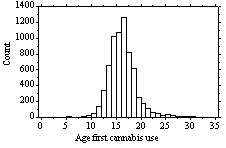 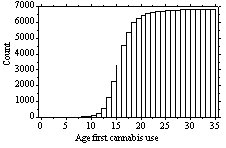
5.2 Use
of Other Drugs
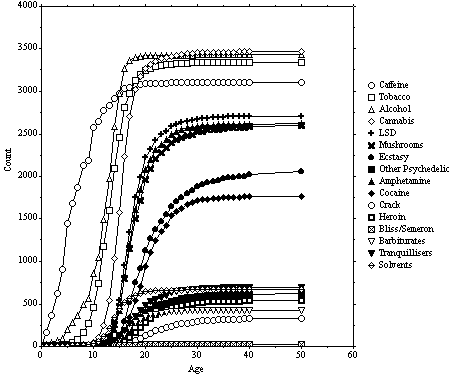
5.2.1 The
Drug Acquisition Curves show the numbers who had
tried each drug by a given age. Very few people
who have not tried a drug by age 25 will start
using it afterwards, the only exception being
ecstasy (and to a lesser extent crack cocaine),
which both arrived on the scene when many existing
drug users were in their 30s and 40s. Note - "tea/coffee"
was not included in the questions from one batch
of surveys. "Bliss" was included as
a fictitious drug from 1994-98, when it came to
our attention that a "herbal high" was
being sold under that trade name, for 1999 and
2000 we used the same "bogus" drug as
the Home Office (i.e. Semeron) which was given
the bogus street name "space".
5.3 Drug
Prevalence
5.3.1 The lifetime prevalence
of using most drugs has remained relatively stable
among the user population as a whole, however
amphetamine and LSD appears to be declining steadily,
whereas cocaine and ecstasy appear to be increasing
slightly. Prevalence of magic mushroom use (not
shown) is similar to that of LSD. Crack and Ecstasy
were not listed options in 1984, although 1% mentioned
MDA as a write-in option. Users of crack in 1984
(then known as freebase) did not report it directly,
but some of the cocaine would have been used in
that form.
Lifetime prevalence of use of different
drugs among users of any drug by year
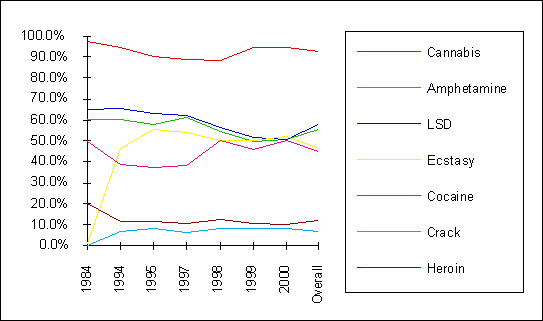
5.4 Frequency of use
5.4.1 Users of each drug were
asked to state how often they used the drug. Other
than cannabis and legal drugs (caffeine, tobacco,
alcohol), there were few daily users, with experimental
or occasional use the norm.
Frequency of Cannabis use by year
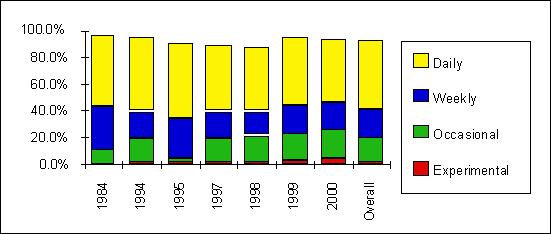
Frequency
of Amphetamine use by year
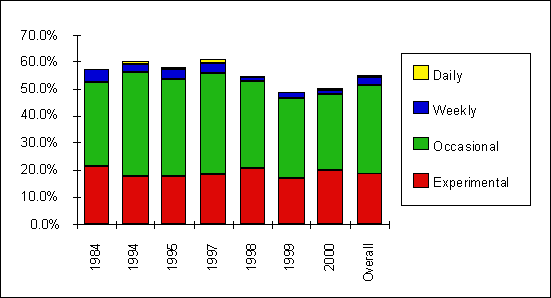
Frequency of LSD use by year
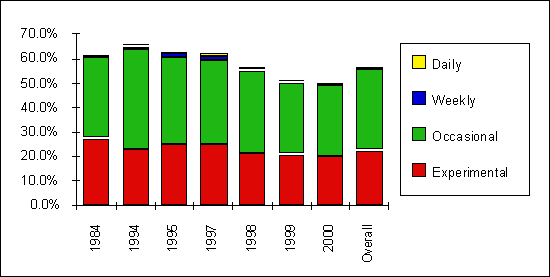
Frequency of Ecstasy use by year
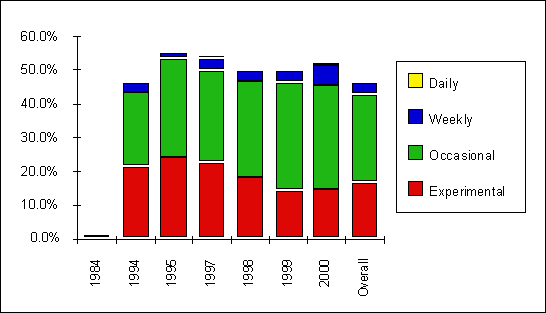
Frequency
of Cocaine use by year
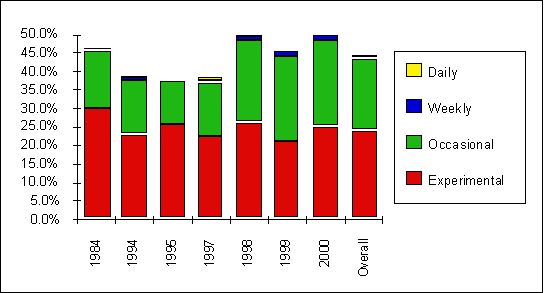
Frequency
of Crack Cocaine use by year
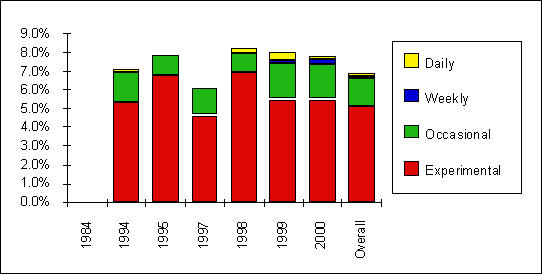
Frequency
of Heroin use by year
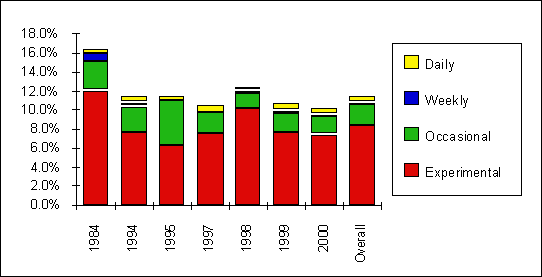
5.5 Busts/deterrence
5.5.1 Laws
prohibiting drug use and possession are frequently
justified on the basis that they deter people
from using drugs. However the effect of a drugs
arrest tends to consolidate or stimulate drug
use, rather than deterring the user from continuing
or indeed experimenting with other drugs. Drug
users who have been arrested for drugs offences
typically use a wider range of drugs more frequently
and more heavily than users with clean records.
They also tend to give higher ratings to drugs.
|
Drug use frequency, purchasing,
Subjective Ratings
& other consumption patterns
by
whether ever busted (1994-98 Consolidated);
|
| |
Cannabis offence
|
Other
drug offence
|
Other
offence
|
| |
No
|
Yes
|
p
|
No
|
Yes
|
p
|
No
|
Yes
|
p
|
|
Base
(% of total)
|
2831
78%
|
792
22%
|
|
3389
94%
|
234
6%
|
|
3181
88%
|
442
12%
|
|
|
Age
|
25.71
|
29.01
|
.064
|
27.38
|
30.03
|
<.0001
|
26.24
|
28.52
|
<.0001
|
|
Caffeine
|
|
Rating
|
5.98
|
5.79
|
ns
|
6.14
|
5.60
|
ns
|
5.97
|
5.68
|
ns
|
|
Frequency
|
3.15
|
3.30
|
ns
|
3.19
|
3.27
|
ns
|
3.18
|
3.20
|
ns
|
|
Spending
|
4.39
|
5.09
|
ns
|
4.41
|
5.05
|
ns
|
4.50
|
4.87
|
ns
|
|
Tobacco
|
|
Rating
|
3.82
|
3.46
|
ns
|
3.72
|
3.56
|
ns
|
3.72
|
3.91
|
ns
|
|
Frequency
|
2.76
|
3.10
|
ns
|
2.81
|
3.20
|
<.01
|
2.80
|
3.13
|
<.0001
|
|
Spending
|
21.00
|
24.30
|
ns
|
18.56
|
24.35
|
ns
|
19.93
|
34.31
|
<.0001
|
|
Cigs/day
|
8.81
|
10.63
|
ns
|
10.14
|
10.82
|
ns
|
8.94
|
11.45
|
<.0001
|
|
Alcohol
|
|
Rating
|
5.97
|
5.51
|
ns
|
6.68
|
5.22
|
.0001
|
5.90
|
5.62
|
.057
|
|
Frequency
|
2.63
|
2.65
|
ns
|
2.88
|
2.66
|
ns
|
2.63
|
2.70
|
ns
|
|
Spending
|
33.21
|
32.28
|
ns
|
38.71
|
34.54
|
ns
|
32.64
|
37.13
|
.066
|
|
Units/ week
|
18.43
|
18.21
|
<.001
|
25.46
|
23.00
|
ns
|
18.25
|
22.09
|
<.001
|
|
Cannabis
|
|
Rating
|
8.51
|
9.11
|
ns
|
8.82
|
9.10
|
<.05
|
8.64
|
8.72
|
ns
|
|
Frequency
|
2.97
|
3.51
|
ns
|
3.19
|
3.53
|
<.0001
|
3.06
|
3.33
|
<.0001
|
|
Used/ month (g)
|
21.17
|
31.57
|
ns
|
21.56
|
40.27
|
<.05
|
23.06
|
87.13
|
<.05
|
|
Bought/ month (g)
|
42.18
|
101.7
|
ns
|
43.55
|
75.56
|
<.05
|
46.98
|
103.38
|
<.0001
|
|
£Spending 1
|
36.53
|
90.98
|
ns
|
29.88
|
79.22
|
<.05
|
44.54
|
78.8
|
<.05
|
|
£Spending 2
|
67.44
|
188.96
|
ns
|
59.53
|
99.29
|
.051
|
84.92
|
137.76
|
<.05
|
|
Spliffs smoked/day
|
5.05
|
6.86
|
<.05
|
5.72
|
8.57
|
<.0001
|
5.39
|
7.15
|
<.0001
|
|
Rolled/ day
|
4.82
|
6.24
|
ns
|
4.73
|
7.55
|
ns
|
5.06
|
6.60
|
ns
|
|
Pipes/ day
|
2.23
|
3.23
|
<0.1
|
2.75
|
4.90
|
<.05
|
2.34
|
4.17
|
<.0001
|
|
Plants Grown
|
13.37
|
25.58
|
ns
|
11.38
|
65.13
|
<.05
|
15.68
|
43.95
|
<.0001
|
|
% bought
for own use
|
69.06
|
73.03
|
ns
|
70.15
|
70.06
|
ns
|
69.86
|
70.41
|
ns
|
|
Drug use frequency, purchasing
& other consumption patterns
by whether ever busted
|
| |
Cannabis offence
|
Other
drug offence
|
Other offence
|
| |
No
|
Yes
|
p
|
No
|
Yes
|
p
|
No
|
Yes
|
p
|
|
LSD
|
|
Rating
|
6.74
|
7.55
|
ns
|
7.83
|
7.01
|
ns
|
6.97
|
6.68
|
ns
|
|
Frequency
|
1.01
|
1.31
|
<.0001
|
1.38
|
1.61
|
<.005
|
1.06
|
1.33
|
<.0001
|
|
Spending
|
1.38
|
2.75
|
ns
|
2.46
|
3.08
|
ns
|
1.54
|
2.92
|
<.01
|
|
% bought for personal use
|
81.25
|
80.89
|
ns
|
98.64
|
75.53
|
.052
|
80.12
|
86.39
|
ns
|
|
Ecstasy
|
|
Rating
|
6.56
|
6.64
|
<.05
|
7.44
|
7.32
|
ns
|
6.62
|
6.74
|
ns
|
|
Frequency
|
.85
|
1.01
|
<.0001
|
1.17
|
1.54
|
<.005
|
0.89
|
1.11
|
<.0001
|
|
Spending
|
5.58
|
8.65
|
ns
|
6.92
|
11.64
|
<.05
|
5.73
|
11.38
|
<.0001
|
|
% bought for personal use
|
84.52
|
80.10
|
ns
|
86.94
|
80.54
|
ns
|
83.33
|
83.84
|
ns
|
|
Amphetamine
|
|
Rating
|
5.21
|
4.82
|
ns
|
5.32
|
5.29
|
ns
|
5.15
|
5.05
|
ns
|
|
Frequency
|
1.05
|
1.27
|
<.01
|
1.33
|
1.47
|
<.05
|
1.07
|
1.41
|
<.0001
|
|
Spending (£)
|
4.13
|
5.83
|
<.05
|
12.38
|
8.19
|
ns
|
3.95
|
10.36
|
<.0001
|
|
% bought for personal use
|
76.30
|
78.54
|
ns
|
72.60
|
78.65
|
ns
|
76.74
|
77.26
|
ns
|
|
Cocaine
|
|
Rating
|
5.51
|
6.09
|
ns
|
6.23
|
6.32
|
ns
|
5.68
|
0.83
|
ns
|
|
Frequency
|
0.56
|
0.93
|
<.005
|
0.85
|
1.10
|
<.0001
|
0.62
|
0.93
|
<.0001
|
|
Spending
|
3.34
|
9.43
|
ns
|
4.69
|
4.92
|
ns
|
2.83
|
16.16
|
<.0001
|
|
% bought for personal use
|
70.09
|
69.28
|
ns
|
80.00
|
76.18
|
ns
|
69.75
|
74.39
|
ns
|
|
Crack
|
|
Rating
|
1.87
|
2.59
|
<.05
|
4.06
|
2.82
|
ns
|
2.00
|
2.83
|
<.05
|
|
Frequency
|
0.07
|
0.15
|
<.005
|
0.10
|
0.28
|
<.0001
|
0.08
|
0.19
|
<.0001
|
|
Spending
|
0.34
|
3.68
|
ns
|
6.25
|
2.55
|
ns
|
0.97
|
1.92
|
ns
|
|
% bought for personal use
|
45.83
|
37.50
|
ns
|
ö
|
50.00
|
ns
|
42.11
|
50.00
|
ns
|
|
Heroin
|
|
Rating
|
2.17
|
3.00
|
<.005
|
4.35
|
3.20
|
ns
|
2.28
|
3.35
|
<.0001
|
|
Frequency
|
0.12
|
0.26
|
<.0001
|
0.35
|
0.45
|
<.01
|
0.14
|
0.35
|
<.0001
|
|
Spending
|
1.32
|
3.70
|
<.0001
|
30.21
|
13.44
|
<.05
|
1.51
|
11.52
|
<.0001
|
|
% bought for personal use
|
62.38
|
60.71
|
ns
|
ö
|
100
|
ns
|
62.00
|
77.78
|
ns
|
|
"Semeron/ Bliss"*
|
|
Rating
|
1.88
|
1.44
|
<.005
|
5.60
|
1.70
|
<.005
|
1.92
|
1.27
|
.069
|
|
Frequency
|
0.01
|
0.01
|
<.0001
|
0.15
|
0.03
|
<.0001
|
0.01
|
0.03
|
<.05
|
|
Spending
|
0.01
|
0.09
|
ns
|
0.10
|
0
|
ns
|
0.02
|
0
|
ns
|
|
Tranquillisers
|
|
Rating
|
2.71
|
2.62
|
ns
|
3.36
|
3.10
|
ns
|
2.63
|
3.21
|
<.05
|
|
Frequency
|
0.19
|
0.32
|
<.0001
|
0.50
|
0.55
|
.081
|
0.20
|
0.46
|
<.0001
|
|
Spending
|
0.12
|
0.21
|
<.001
|
0.83
|
1.01
|
ns
|
0.11
|
0.76
|
<.0001
|
|
Solvents
|
|
Rating
|
1.51
|
1.49
|
ns
|
1.20
|
1.28
|
ns
|
1.36
|
2.17
|
<.001
|
|
Frequency
|
0.14
|
0.16
|
ns
|
0.19
|
0.18
|
ns
|
0.13
|
0.25
|
<.0001
|
|
Spending
|
0.07
|
0.13
|
ns
|
0.27
|
0.11
|
ns
|
0.06
|
0.29
|
<.0001
|
* The list of drugs on the multiple-choice
questions changed in 1998. Ketamine was not previously
specified, replacing "Other Psychedelic".
"Semeron" is a fictitious substance included
as an error-detector, replacing "Bliss"
in earlier studies- a "legal high" of that
name now exists..
5.5.2 "Busted"
users are much more likely - post arrest - to
initiate use of heroin or crack cocaine, and also
to be willing to try an unknown (fictitious) drug.
|
Prevalence Differences between "Busted"
and "Clean" users
|
|
Drug
|
Cannabis Arrest
|
No
Cannabis Arrest
|
Busted/Clean
ratios
|
|
|
Use(d) drug
|
Might use
|
Never/ Stopped
|
Use(d) drug
|
Might use
|
Never/ Stopped
|
Use(d) drug
|
Use or might
|
Never/ stopped
|
|
Caffeine
|
88.1%
|
0.0%
|
11.9%
|
81.4%
|
0.2%
|
18.4%
|
1.083
|
1.080
|
0.647
|
|
Tobacco
|
83.5%
|
0.0%
|
16.5%
|
78.9%
|
0.1%
|
21.0%
|
1.058
|
1.057
|
0.787
|
|
Alcohol
|
88.3%
|
0.0%
|
11.7%
|
87.4%
|
0.1%
|
12.5%
|
1.011
|
1.009
|
0.935
|
|
Cannabis
|
95.4%
|
0.2%
|
4.4%
|
89.6%
|
0.1%
|
10.2%
|
1.064
|
1.065
|
0.430
|
|
LSD
|
71.9%
|
1.2%
|
26.9%
|
62.1%
|
4.6%
|
33.3%
|
1.158
|
1.096
|
0.808
|
|
Mushrooms
|
75.6%
|
3.1%
|
21.3%
|
60.0%
|
7.6%
|
32.5%
|
1.261
|
1.165
|
0.657
|
|
Ecstasy
|
60.1%
|
6.8%
|
33.1%
|
47.1%
|
7.0%
|
45.9%
|
1.276
|
1.237
|
0.721
|
|
Amphetamine
|
66.2%
|
0.6%
|
33.2%
|
56.5%
|
2.1%
|
41.3%
|
1.171
|
1.138
|
0.803
|
|
Cocaine
|
58.3%
|
2.9%
|
38.8%
|
37.3%
|
7.1%
|
55.6%
|
1.565
|
1.380
|
0.697
|
|
Crack
|
13.1%
|
4.4%
|
82.5%
|
5.4%
|
3.3%
|
91.3%
|
2.413
|
2.012
|
0.904
|
|
Heroin
|
24.9%
|
3.8%
|
71.3%
|
8.5%
|
3.3%
|
88.2%
|
2.921
|
2.433
|
0.808
|
|
Bliss/Semeron
|
0.8%
|
3.5%
|
95.7%
|
0.6%
|
2.0%
|
97.3%
|
1.364
|
1.611
|
0.983
|
|
Tranx
|
22.4%
|
2.7%
|
74.9%
|
12.9%
|
3.5%
|
83.7%
|
1.739
|
1.539
|
0.895
|
|
Solvents
|
12.4%
|
0.6%
|
87.0%
|
10.1%
|
0.6%
|
89.3%
|
1.226
|
1.215
|
0.974
|
|
Base
|
840
|
2782
|
|
5.5.3 The
prevalence data tells half the story, as this
may simply reflect the greater tendency of police
to arrest heavier users, particularly of Class
A drugs. However, by comparing the age of initiation
to particular drugs to the age of the first "bust",
it can be seen that initiation to particularly
heroin and crack usually follows the first drugs
bust, supporting the hypothesis of a causal effect.
|
Initiation to use of different drugs
before and after first drug arrest
(1998)
|
|
Drug
|
Age First Use
|
Initiated before arrest
|
Initiated
same age
|
Initiated
after first arrest
|
Same age or older
|
|
Mean age first bust
|
22.53
|
n
|
%
|
n
|
%
|
n
|
%
|
% of busted
|
Total % after age 22.5 yrs
|
|
Caffeine
|
7.91
|
228
|
97.5
|
4
|
1.7
|
3
|
0.9
|
2.6
|
0.7
|
|
Tobacco
|
13.85
|
238
|
97.1
|
4
|
1.6
|
3
|
1.2
|
2.8
|
0.7
|
|
Alcohol
|
12.41
|
248
|
98.4
|
1
|
0.4
|
3
|
0.8
|
1.2
|
0.4
|
|
Cannabis
|
16.29
|
238
|
94.1
|
12
|
4.7
|
3
|
1.2
|
5.9
|
1.4
|
|
Amphet.
|
18.58
|
172
|
78.5
|
18
|
8.2
|
29
|
13.2
|
21.4
|
5.5
|
|
Base Amph.
|
20.67
|
59
|
53.2
|
21
|
9.9
|
41
|
36.9
|
46.8
|
13.1
|
|
Cocaine
|
21.51
|
83
|
42.4
|
31
|
15.8
|
82
|
41.8
|
66.6
|
16.3
|
|
Opium
|
21.52
|
60
|
48.0
|
20
|
16.0
|
45
|
36.0
|
52.0
|
16.5
|
|
Mushrooms
|
19.99
|
135
|
61.6
|
25
|
11.4
|
59
|
26.9
|
38.3
|
10.1
|
|
Ketamine
|
23.60
|
12
|
20.3
|
9
|
15.3
|
38
|
64.4
|
79.7
|
24.9
|
|
Crack
|
24.03
|
7
|
13.5
|
7
|
13.5
|
38
|
74.0
|
87.5
|
35.2
|
|
Heroin
|
21.83
|
36
|
46.2
|
10
|
12.8
|
32
|
41.0
|
53.8
|
20.4
|
|
LSD
|
18.81
|
160
|
72.1
|
30
|
13.5
|
32
|
14.4
|
27.9
|
7.6
|
|
Ecstasy
|
22.79
|
69
|
39.7
|
21
|
12.1
|
84
|
48.3
|
60.3
|
15.8
|
|
Barbs
|
17.95
|
42
|
75.0
|
4
|
7.1
|
10
|
17.9
|
25.0
|
10.5
|
|
Tranx
|
19.77
|
59
|
67.8
|
7
|
8.0
|
21
|
24.2
|
32.2
|
10.7
|
|
Solvents
|
14.77
|
55
|
90.2
|
3
|
4.9
|
3
|
4.9
|
9.8
|
3.0
|
Totals
based on 1128 of 1153 respondents (35 respondents gave
no age data)
6. The
Cannabis Market
6.1 Prices
of cannabis resin have been falling steadily since
1994, actually having peaked in the late 1980s, with
the most substantial falls seen since 1998. Data for
a range of cannabis resin and herbal varieties are
available, only the most common Moroccan/Soap Bar
resin is shown. Prices for imported herbal cannabis
are also in decline, as is the market share, which
has been overtaken by domestically produced cannabis
(skunk). Skunk prices have remained relatively stable
in the region of £6 per gram, with a price premium
as compared to resin at all market levels..
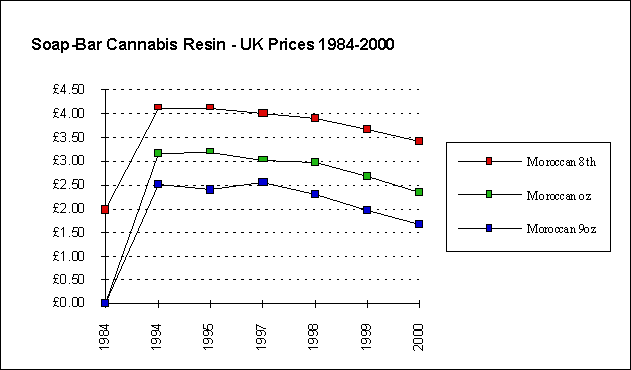
6.2 Although
Moroccan (soap-bar) resin and "skunk" are
the most common forms of cannabis found, other types
do occur infrequently. Liquid cannabis (hash oil)
is occasionally reported, although much is believed
to reconstituted into solid form as "formula"
resin.
|
Types of Cannabis Available in the
UK
|
|
Cannabis Resin
|
|
Type/Variety
|
Appearance
|
Market Share
|
Potency
(%
THC)
|
|
Moroccan ("soap-bar")
|
Hard, mid-brown, 250g blocks/bars
|
~50%
|
3-7%
|
|
Asian ("Black", "Red
Seal")
|
Soft, dark brown, 500g-1kg slabs
|
~5%
|
3-7%
|
|
Exotics (e.g. "Pollen",
Charas, Nepalese, Minali)
|
Soft light brown hand-pressed blocks
(Pollen), hard dark brown (Charas, Nepalese), soft
cylinders/medallions (Minali), flat fibrous slabs
(Slate)
|
<1%
|
5-15%
|
|
Herbal Cannabis
|
|
Imported (e.g. African, Thai, Jamaican)
|
brown/green, usually compressed
with stalk and seeds
|
~5%
|
3-7%
|
|
Skunk
|
green, strong odour, seedless flowers
|
~35%
|
8-20%
|
|
Homegrown
|
green, leaf only
|
~5%
|
0-5%
|
7. Methods of Cannabis Use
7.1 Around
75% of cannabis is smoked in joints/spliffs/reefers
mixed with tobacco, 5% in pure cannabis reefers, around
15% in pipes, and around 5% eaten - either on its
own or mixed in food (e.g. space cakes) or drink (e.g.
bhang, cannabis tea), with small numbers smoking using
other methods e.g. hot knives - where resin is pressed
between red-hot knife blades and the fumes inhaled
through a bottomless bottle, or "buckets"
where smoke is drawn into a large bottle and inhaled
when cooler.
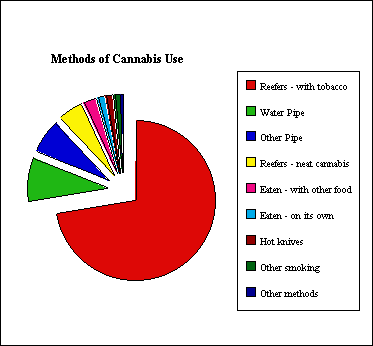
7.2 Although most users smoke
between 1 and 6 spliffs per day, smoking up to 20
per day is not uncommon. Many of those smoking 20
reefers will be primarily addicted to the tobacco
in their "weak" reefers, but still claim
they don"t smoke cigarettes in a state of denial.
The mixing of cannabis with tobacco may explain why
the proportion of daily users in our surveys are much
higher than those found in the USA where cannabis
is smoked "neat".
Distribution of number of "spliffs"
(reefers) smoked per day
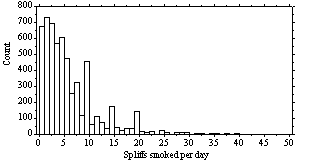
7.3 Users
of both sexes tend to smoke nearly twice as many reefers
per day at weekends than on weekdays. Many occasional
users confine use to weekends only.
|
Differences in Daily Reefers Smoked
Midweek & Weekends (2000 survey)
|
|
Sex
|
Weekdays
|
Weekends
|
|
Female
|
5.12
|
9.24
|
|
Male
|
6.12
|
11.88
|
|
Not Stated
|
6.74
|
10.32
|
|
Total
|
5.89
|
10.89
|
7.3 The
Forensic Science Service has analysed unsmoked reefers,
and typically quote 7 reefers per gram of resin, and
5 of herbal cannabis. The distribution of analysed
reefers is similar to the predicted data derived from
the monthly amount used and the number of reefers
smoked per day.
Distribution
of cannabis/resin per reefer (IDMU data)
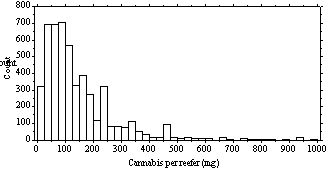
8. Settings of use
8.1 Cannabis
is mainly used in the home, although it is being smoked
more frequently in public places, including pubs,
clubs, parks, streets, gigs and pop festivals.
|
Settings of cannabis transactions
|
|
Supply Offences
|
Count:
|
Percent:
|
|
Ever bought for others
|
1423
|
78.62%
|
|
Never bought for others
|
387
|
21.38%
|
|
Share Spliffs
|
1619
|
96.31%
|
|
Never share spliffs
|
62
|
3.69%
|
|
Never sold
|
673
|
39.59%
|
|
Ever sold
|
1027
|
60.41%
|
|
Sold at cost
|
421
|
24.76%
|
|
Sold for profit
|
261
|
15.35%
|
|
Sold both cost/profit
|
204
|
12.00%
|
|
Base (sale)
|
1700
|
|
|
Cannabis Purchase
|
Count:
|
Percent:
|
|
Home Town Friends
|
839
|
45.0%
|
|
Other Town Friends
|
113
|
6.1%
|
|
Both Friends
|
115
|
6.2%
|
|
Total Friends
|
1067
|
57.2%
|
|
Home Town Dealer
|
598
|
32.1%
|
|
Other Town Dealer
|
99
|
5.3%
|
|
Both Dealers
|
100
|
5.4%
|
|
Total Dealers
|
797
|
42.8%
|
|
Base (Purchase)
|
1864
|
|
8.2 The
majority of users smoke cannabis socially, and virtually
all will be technically guilty of supply offences
merely by "passing the spliff". Communal
buying is another common form of social supply, where
a group of friends "chip in" to purchase
a larger amount. Most cannabis is bought from friends
in users" own towns or cities, although commercial
dealers are another common source. Around 10% of users
will travel to buy cannabis.
9 Reasons
for use
|
Why Use Cannabis? (1994 data)
|
|
No of
reports
|
Reasons Given/ quotes
|
|
231
|
Enjoyment
|
|
32
|
Enjoy with ... general
|
|
14
13
4 ea.
|
Enjoy with ...
Sex - "Feel bliss out buzz erotic love play"
Music
Art, other drugs/alcohol
|
|
196
|
Relaxation/ Calming/ Stress Relief
|
|
90
|
Relax and ... general
|
|
76
43
30
38
9
|
Relax and ...
Socialise
Enjoy
Pain/ hangover killer
Enlighten
Music - "Reduce stress, boredom, and alcohol
craving"
|
|
89
8
5
2
|
Inspiration, Perception, Meditation, Spiritual
Look at reality/ what's important
Know self, "Tool for life's events", "To turn on,
tune in, drop out", "It seems to grow my ears, eyes,
& heart/brain", "Not to commit moral suicide"
Closer to God
|
|
47
|
Get
Stoned/High/Intoxicated/fucked/mullered, "Gets
me fried, pumps my juice", "Love feeling like
a gibbering mess", "Mong out"
|
|
42
|
Better than alcohol/ cigs
|
|
39
|
Medical
uses (5 x Asthma, 1 x M.S., 7 x pain relief)
|
|
31
2
|
Why
Not /Because/ I choose to
Because I can
|
|
14
|
Escapism
- "It"s better than real life"
|
|
9
|
Avoid boredom
|
|
6
|
Cheap
|
|
13
|
Habit
|
|
4
|
Sensual
|
|
6
3 ea.
|
It's nice/amazing/beautiful/heaven/ good shit
"It's part of life", "It makes common sense"
|
|
12
|
Happy/ Euphoric/ Laughter
|
|
11
|
Non aggressive
|
|
8
|
Tastes nice
|
|
5
|
Natural/ plant
|
|
4 ea.
|
Don't be stupid, try it and see
|
|
3 ea.
|
Anti-depressant, experimental, to smoke/ mainly
in spliffs
|
|
2 ea.
|
Mild psychedelic, can"t remember
|
|
1 ea.
|
Light relief, "Yes", "I'm a fool", "the illusion
of clamping",
"free & not fattening", "Family tradition",
"It's the word", "live in London", "Gods gift",
"hope," "same reasons as you", "minor offence",
"What was the question again?", "not enough space",
"various", "It's from Mother Nature, I like the
effect, the world is too fast" "A complex mixture
of bio-psycho-social causes, and I like it" "Love
to chill, thrill, humble sinner" "Lesser of several
evils" "Searching for real dope"
|
|
5
|
Don"t use any more
|
9.1 The
majority of users quote enjoyment or relaxation as
the primary reason for using cannabis. Use for inspiration/creativity,
and hedonism are more common than medicinal use.
10 Cannabis and Health
10.1 Health
Problems:
10.1.1 Although many users
experience health problems from cannabis use,
in most cases these are occasional and of mild
severity. Commonly reported problems include panic
attacks, apathy, memory problems and paranoia.
|
Health Problems reported by Cannabis
Users
(includes problems attributed to
other drugs - 1999 data)
|
|
Frequency/ Severity
|
Headache
|
Paranoia
|
Chest Problems
|
Panic/ Freakout
|
Anxiety
|
Psychosis
|
|
Never
|
30.8%
|
19.8%
|
33.3%
|
42.5%
|
29.7%
|
55.4%
|
|
Once or twice
|
20.1%
|
17.6%
|
11.0%
|
13.7%
|
14.9%
|
2.6%
|
|
Occasionally
|
16.1%
|
22.0%
|
16.0%
|
5.4%
|
14.1%
|
1.2%
|
|
Regularly
|
1.5%
|
6.4%
|
3.5%
|
0.7%
|
3.8%
|
0.4%
|
|
All the time
|
0.3%
|
1.4%
|
1.2%
|
0.7%
|
1.0%
|
0.4%
|
|
Total ever
|
38.0%
|
47.3%
|
31.8%
|
20.6%
|
33.7%
|
4.6%
|
|
Not Applicable
|
20.8%
|
13.4%
|
20.5%
|
27.4%
|
18.8%
|
35.5%
|
|
Mild
|
23.3%
|
24.2%
|
16.5%
|
8.1%
|
19.4%
|
2.3%
|
|
Moderate
|
10.4%
|
15.5%
|
12.1%
|
6.3%
|
9.3%
|
1.4%
|
|
Severe
|
2.1%
|
3.8%
|
1.6%
|
4.8%
|
2.4%
|
0.8%
|
|
Total
|
35.7%
|
43.5%
|
30.2%
|
19.1%
|
31.2%
|
4.5%
|
|
Frequency/ Severity
|
Apathy
|
Running
Out (of
drug)
|
Withdrawal
|
Balance
|
Domestic accidents
|
Vomiting
|
|
Never
|
12.4%
|
20.7%
|
38.0%
|
20.8%
|
41.5%
|
30.0%
|
|
Once or twice
|
5.4%
|
9.9%
|
6.6%
|
13.2%
|
8.0%
|
18.3%
|
|
Occasionally
|
20.6%
|
17.3%
|
6.4%
|
18.9%
|
2.3%
|
8.4%
|
|
Regularly
|
20.9%
|
8.8%
|
1.5%
|
8.3%
|
0.5%
|
1.1%
|
|
All the time
|
6.9%
|
6.3%
|
0.6%
|
2.0%
|
0.3%
|
0.2%
|
|
Total ever
|
53.7%
|
42.3%
|
15.2%
|
42.4%
|
11.1%
|
28.0%
|
|
Not Applicable
|
7.9%
|
17.6%
|
25.0%
|
13.8%
|
27.2%
|
18.5%
|
|
Mild
|
16.9%
|
15.2%
|
7.4%
|
22.9%
|
8.0%
|
9.9%
|
|
Moderate
|
24.4%
|
8.6%
|
4.3%
|
12.9%
|
1.5%
|
12.0%
|
|
Severe
|
7.7%
|
9.6%
|
1.8%
|
2.9%
|
0.6%
|
4.0%
|
|
Total
|
49.0%
|
33.4%
|
13.5%
|
38.7%
|
10.0%
|
26.0%
|
|
Frequency/ Severity
|
Fatigue
|
Overdose/ "Whitey"
|
Thinking
|
Memory
|
Halluci-nation
|
Other Problems
|
|
Never
|
14.1%
|
28.9%
|
19.4%
|
15.7%
|
30.2%
|
3.9%
|
|
Once or twice
|
9.6%
|
21.4%
|
10.8%
|
10.7%
|
14.0%
|
0.6%
|
|
Occasionally
|
20.2%
|
5.5%
|
15.3%
|
18.0%
|
8.2%
|
0.7%
|
|
Regularly
|
10.8%
|
0.6%
|
7.6%
|
10.3%
|
1.4%
|
0.9%
|
|
All the time
|
2.4%
|
0.0%
|
2.9%
|
3.9%
|
0.8%
|
0.4%
|
|
Total ever
|
42.9%
|
27.5%
|
36.6%
|
42.8%
|
24.5%
|
2.7%
|
|
Not Applicable
|
8.6%
|
18.1%
|
11.6%
|
10.6%
|
19.8%
|
2.6%
|
|
Mild
|
17.6%
|
9.2%
|
19.2%
|
21.4%
|
11.0%
|
0.2%
|
|
Moderate
|
18.2%
|
9.4%
|
11.8%
|
14.4%
|
8.7%
|
1.2%
|
|
Severe
|
3.2%
|
6.5%
|
3.3%
|
3.1%
|
2.3%
|
0.9%
|
|
Total
|
39.0%
|
25.2%
|
34.2%
|
38.9%
|
22.0%
|
2.3%
|
10.2 Medicinal
use
10.2.1 Medicinal
use of cannabis was first reported in 2737 BC
in China, and "hemp" has a western tradition
as listed by Culpepper. O"Shaughnessy wrote
the first modern medical paper in 1839. Tincture
of cannabis was available in the UK as a medicine
until banned by the Misuse of Drugs Act in 1971.
10.2.2 After
over a century of research primarily aimed at
discovering the dangers of cannabis, Cannabis
was described by the British Medical Association
as "a remarkably safe drug with a side effects
profile superior to many conventional medications".
10.2.3 The
cannabinoid receptor has been found in many areas
of the nervous system and bodily tissues, including
the skin and gut. It is suggested that the receptor,
reacting to the body"s own cannabinoids (e.g.
anandamide) regulates the pain threshold. New
research is emerging at an exponential rate, with
papers being published at the rate of one a day
into this developing field of pharmacology.
10.2.4 Conditions
which may be improved by cannabis include:
(a) Multiple
Sclerosis - Recent research is very encouraging,
suggesting the condition may result from disorders
of the body"s own cannabinoid metabolism,
with many patients reporting dramatic improvement
of symptoms.
(b) Pain
- including arthritis, spinal injury, migraine
etc and other forms of chronic pain
(c) Asthma
- THC has powerful bronchodilator properties,
although cannabis smoke can irritate the lungs.
(d) Gastrointestinal
- THC slows the gut, and has been claimed
to improve disorders such as Crohn"s
disease and irritable bowel syndrome
(e) AIDS/Cancer
- THC or cannabis improves appetite and reduces
nausea and the wasting associated with AIDS
or cancer chemotherapy treatment. While several
components of cannabis smoke have been found
to be carcinogenic, some research has suggested
there may be a protective effect of certain
cannabinoids against breast or skin cancers.
(f) Strokes
- Dexanabinol, a synthetic cannabinoid, has
been found to dramatically reduce the death
of brain cells following a stroke or severe
head injury.
(g) Glaucoma
- THC reduces intraocular pressure, although
relatively high dosages and frequent repetition
are needed. Glaucoma is the second most common
cause of blindness.
(h) Epilepsy
- Various cannabinoids (notably cannabidiol
or CBD present mainly in resin) have powerful
anticonvulsant properties.
(i) Stress
- The most commonly-reported effect of cannabis
is relaxation and stress relief. However cannabis
increases heart rate, whilst reducing blood
pressure via lowered smooth muscle tone in
the arteries - the net effect being similar
to changing down a gear when driving uphill.
(j) Mental
Health: Several individuals claim to have
reduced psychiatric symptoms after replacing
prescribed medications (antidepressants or
tranquillisers) with cannabis.
11 Cannabis and Driving
11.1 Drug
driving has become a hot topic over recent years,
with much ill-informed opinion from motoring organisations.
The Transport Research Laboratory has been conducting
tests, which confirm most previous findings that cannabis:
(a) has
no effect on reaction time
(b) marginally
affects tracking ability
(c) drivers
under the influence tend to be more careful, driving
more slowly, leaving a larger gap, and undertaking
fewer aggressive driving manoeuvres.
11.2 New
users of cannabis, and inexperienced drivers, tend
to be most impaired, whereas regular users or drivers
show little effect on performance. Skunk tends to
impair performance more than resin. Our results show
that women tend to have a higher risk of impairment,
as there may be less scope for improvement in "driving
behaviour", but that most drivers have similar,
or even lower, rates of accidents compared to those
expected for the same age and sex.
11.3 Driving
(or being in charge of a vehicle etc) whilst unfit
through drink or drugs has long been an offence under
the Road Traffic Acts. To prove this, the police have
to show a driver is unfit, meaning that the ability
to drive properly is impaired, and the presence of
drugs which can cause impairment.
11.4 The
police have been steadily improving their enforcement
techniques (now using blood rather than urine tests)
and have developed "field impairment tests",
based on tests used in the US for alcohol impairment
- examining a drivers performance in a number of tasks:
(a) Pupil
size (cannabis has only a marginal effect on pupil
diameter)
(b) Romberg
test (head back, legs apart, eyes closed, asked
to estimate when 30 seconds have passed - observe
balance and accuracy of time estimation)
(c) Walk
& Turn test - (heel to toe walk, swivel turn
and retrace steps along straight line - observe
accuracy of following instructions and balance)
(d) One-legged
stand - (asked to stand on either leg, observe
balance)
(e) Finger
to nose test - (observe co-ordination, using correct
hand etc)
11.5 IDMU
has recommended that such tests be improved and made
more objective - e.g. being recorded on videotape,
and introduction of in-car simulators to test tracking
and reaction times as objective measures of impairment.
In addition, we have recommended that at least two
blood samples be taken 15 minutes apart, in order
to distinguish between acute intoxication and baseline
levels, as cannabis metabolites can be detected in
body fluids for up to a month after use.
12 Policy
Options - Decriminalisation & alternatives
12.1 Is
Decriminalisation Desirable?
12.1.1 If
decriminalisation involves removing criminal penalties
for possession (e.g. of less than a designated
amount), but leaving supply of drugs in the hands
of criminals, there would be some benefits, but
many problems would remain.
(a) Benefits
(i) The
move would be popular among users of drugs,
reducing the levels of conflict between
young people, police and society
(ii) Removing
the threat of a criminal record (and/or
expunging existing criminal records for
simple possession) would reduce the financial
impact of an arrest on the individual
and society.
(iii) The
credibility of government messages among
wide sections of society may increase.
Our recent survey showed that the least
trusted sources of drugs information were
Government Ministers, the Drugs Czar,
and the Police.
(iv) Society
as a whole could benefit from a more tolerant
climate of individual rights and responsibilities,
with a less authoritarian relationship
between the government and its citizens.
(b) Problems
(i) Leaving
civil penalties in place for possession
would not remove the "naughty"
or "forbidden fruit" image of
drugs, and would decrease the attractions
of usage.
(ii) Civil
fines would be paid by a small minority
of users (those who are caught), and would
therefore represent a very inefficient
form of taxation.
(iii) If
demand increases, the untaxed profits
of drug traffickers would increase, and
with this the levels of corruption and
violence associated with any illegal trade.
(iv) Decriminalisation
would mean users still having to get their
supply from a source. If the "legal"
source of drug (GP, licensing) is inferior
in quality to the "illegal"
sources, then the criminal control of
the drug trade would not be halted. To
be effective the criminal element that
controls the supply of drugs must be put
out of business. This can be achieved
by ensuring the supply of drugs is at
least of a standard users are already
accustomed to. In the case of cannabis
the easiest solution would be to allow
anyone to grow their own supply for own
personal use only. This would enable relatively
law abiding citizens who only smoke cannabis
to avoid visiting criminal suppliers.
(v) The
government would not benefit from Excise
Duty revenues payable on (particularly)
cannabis. Our surveys have indicated that
such duties, along with reduced enforcement
costs, could generate between £2 Billion
and £5 Billion per year for the exchequer.
12.2 What
are the practical alternatives?
12.2.1 Status
Quo - No change in legislation. Public opinion
is steadily moving towards support of drug law
reform and some form of liberalisation. Opportunities
have been missed in the past (e.g. following Wooton
Report and 1979 ACMD report) to reduce the criminal
status of cannabis, and those failures are at
least in part responsible for the levels of drug
problems we face today (ten times as many drug
users/arrests today as when the Misuse of Drugs
Act was introduced)
12.2.2 Reduce
penalties (reschedule cannabis to class C,
Ecstasy/LSD etc. to class B) - These proposals
from the Police Foundation in essence echo those
of the ACMD in 1979. This would represent tinkering
with the system, as the damaging effects of a
criminal record for drugs on the individual and
society would remain.
12.2.3 Regulation/Licensing:
In the long term, some form of regulated supply
of cannabis must be considered. The extent to
which licensing could cover existing illicit preparations
would depend on international agreements (i.e.
for cannabis resin or herbal imported from countries
where production remains illegal), although domestic
production could supply the bulk of the UK cannabis
market. The objective of such models would be
to satisfy existing demand without creating additional
demand. Different models may be appropriate for
different drugs:
(a) Prescription
and dispensation from Pharmacy - this
could be appropriate for opiates, but would
impact on NHS resources (GPs" time).
Individual use could be regulated.
(b) Individual
licenses to possess/purchase - Users could
apply for a licence (smartcard?) which would
enable them to buy (e.g. opiates) in appropriate
amounts at or near cost price.
(c) Licenses
to produce - cannabis growers could be
allowed a "duty free" surface area
or lighting wattage, but could apply for licenses
to produce larger amounts. Duty could be levied
at quarterly intervals based on the available
surface area, subject to regular inspection.
(d) Licensed
supply
(i) Outlets
such as "coffee shops" could
be licensed to supply cannabis, with appropriate
restrictions on advertising, age restrictions
(as with alcohol or tobacco), and location
(e.g. not within 1/4 mile of a school).
(ii) Alternatives
would include a "club" model
whereby licensed clubs could supply cannabis
to their members, who would have to produce
a membership card. Reciprocal agreements
could allow cards to be valid in all clubs
within an association.
12.2.4 Free
Market (Legalisation) - This would involve
drugs being sold in normal retail outlets (e.g.
supermarkets/tobacconists) without significant
controls. Excise duties could be levied on producers
and/or wholesalers as with tobacco or alcohol.
This policy would probably lead to increased usage
(particularly among middle-aged or elderly citizens),
although this would also generate the highest
duty revenues for government.
13 About IDMU Ltd.
13.1 Description
13.1.1 IDMU
is a small independent research consultancy specialising
in the study of illegal drug consumption patterns,
prices and effects. Our mission is to provide
accurate, up to date and impartial information
on drugs to all parties to the debate over drugs
policy.
13.1.2 IDMU
is funded wholly via professional fees earned
in providing expert evidence for the criminal
and civil courts, with experience of over 900
criminal cases since 1991. The evidence mainly
covers personal consumption and drug valuations,
but includes yields of cannabis cultivation systems,
effects of drugs (re criminal intent, driving
impairment etc.), and a range of other aspects,
most notably therapeutic uses of cannabis.
13.1.3 Other
than legal casework, we have provided consultancy
for GW Pharmaceuticals, the House of Lords enquiry,
the Home Office, Transport Research Laboratory,
and Northamptonshire Police, as well as press
journalists and broadcast media.
13.2 Student
Placements
13.2.1 IDMU
does not have the resources to fund writing up
and publishing the vast majority of our survey
data, and much has never been fully analysed.
Each year we ask a number of core questions, concerning
consumption and prices for a range of drugs, with
core demographic data, but have also asked other
questions including drugs education, driving records
positive and negative effects, best and worst
drug experiences, political affiliation and many
more. Preparations are well advanced to put the
survey on the internet.
13.2.2 We
would be happy to welcome students seeking a research
placement, with a view to preparing articles and
research papers for publication. Longer term projects
can involve inclusion of new survey questions.
Much information could be distilled using multivariate
analyses, if anyone is up to the task.
13.2.3 We
are also seeking people working with drug users,
particularly those using heroin, amphetamine and/or
crack cocaine, to distribute surveys among their
client groups, as we find that problem drug users
are underrepresented.
13.3 Follow-Up
13.3.1 I
am happy to answer your questions via e-mail (mail@idmu.co.uk).
Please be patient, as it can sometimes take a
few weeks to respond, particularly when we are
busy. Please keep questions specific whenever
possible.
13.3.2 Please
also check the FAQ pages on our website, as someone
may already have asked a similar question. Many
of these pages (indexed by drug) contain unpublished
data or literature reviews unavailable elsewhere.
14. Further Reading & Websites
14.1 General
The
IDMU website -www.idmu.co.uk
- Lots of frequently (and not so frequently) asked
questions, on-line publications, legal information,
links and much more.
UK
Cannabis Activists - www.ukcia.org - The main
cannabis information site in the UK, run by activists,
but containing much information as well as argument
Cannabis
Culture - a journey through disputed territory
Matthews P (1999) Bloomsbury
Potology
- Newcombe RD - Lifeline Publications - serious
information presented in a readable and entertaining
format
Science
of Marijuana - Iversen L (2000) - Oxford University
Press
Hashish
- ClarkeRC (1998) Red Eye Press - superb reference
text re types and potencies.
14.2 Consumption & UK Market
Regular
Users - Self-reported drug consumption patterns
and attitudes to drugs among 1333 regular cannabis
users. Atha MJ & Blanchard S (1997) -
IDMU Publications - full 1994 survey results
Regular
Users II - UK Drugs Market Analysis, Purchasing
Patterns & Prices 1997 - Atha MJ, Blanchard
S & Davis S (1999) IDMU Publications
Developing
a methodology for measuring illegal activity for
the UK National Accounts. Groom C, Davies
T & Balchin S (1998) Economic Trends 536 pp33-72
(July)
Drugwatch
- Just Say No - Caplin S & Woodward S
(1995) Corgi - early attempt at quantitative research
How
to get off drugs - Mothner & Weitz (1984)
Penguin - comparative info on amphetamines and
opiates
Mixmag
- always good for drugs articles, particularly
the definitive ecstasy user surveys
Cognition
& long term use of Ganja, Schaeffer et
al (1982) Science - Heaviest cannabis users
Hashish,
studies of long-term use - Stefanis, Dornbush
& Fink (1977) Raven Press
Cannabis
in the Marketplace - Legalise Cannabis Campaign
1980/1984 - analysis of different models of legalised
cannabis distribution
Drug
Seizure and Offender Statistics - Home Office
Statistical Bulletin - published annually, with
supplementary and regional tables, available as
pdf formats on Research, Development & Statistics
directorate website www.homeoffice.gov.uk
14.3 Law
& Politics
The
Law on the Misuse of Drug and Drug Trafficking
Offences, Fortson R (1992) Sweet & Maxwell
Bucknell
& Ghodse on Misuse of Drugs (1996) - Sweet
& Maxwell
Misuse
of Drugs Act 1971 - HMSO
Political
opinions of drug users 1998-2000 Atha &
Davis (2001) - IDMU Publications (on-line)
Drugs
and the Law - Report of the Independent Enquiry
into the Misuse of Drugs Act 1971 Police Foundation
(2001)
14.4 Medicinal
Therapeutic
Uses of Cannabis, British Medical Association
(1997) Harwood Academic Publishers BMA
Marijuana
and Medicine - assessing the Science Base US
National Institute of Medicine (1999) National
Academy Press
Cannabis,
the scientific and Medical Evidence - House
of Lords Science & Technology Select Committee
(1998) The Stationery Office HL paper 151 (Report)
and 151-I (Volume of written & oral evidence)
Marihuana
the Forbidden Medicine Grinspoon L & Bakalar
JB (1997) Yale University Press
Marijuana
Medical Papers - Mikuriya T (Ed) (1972) Medi-Comp
Press - contains many early studies from 1837
to 1971
IDMU
Submission to House of Lords Enquiry Atha,
Davis & Ganly (1998) - reviews of scientific
evidence and analysis of relevant survey data
- available on-line or in volume of evidence published
by Lords Enquiry.
14.5 Driving
Cannabis
and Driving, a review of the literature and commentary.
Ward NJ & Dye L (1999) Road Safety Research
Report No 12 London: DETR
The
Influence of Cannabis on Driving - Sexton
BF et al (2000) Transport Research Laboratory
UK: TRL Report 477
The
Prevalence and role of alcohol, cannabis, benzodiazepines
and Stimulants in non-fatal road crashes.
Hunter et al (1998) Adelaide: Forensic Science/Clinical
& Exp. Pharmacology (Monograph)
The
Influence of Marijuana on Driving Robbe HWJ
(1994) Maastricht, University of Limburg
Drugs
& Driving Atha, Blanchard, Davis &
Liptrot (2001) IDMU - in preparation
14.6 Research
Tools On-line
Drugscope
- www.drugscope.org - Formed by merger
of the National co-ordinating body for the voluntary
sector (SCODA) with the UK"s most comprehensive
drugs library (ISDD).
Medline
- http://www.ncbi.nlm.nih.gov/entrez/query.fcgi?db=PubMed
searchable
database, usually with abstracts, of research
papers in the biological sciences
Media
Awareness Project - www.mapinc.org
- searchable database of 100,000+ media articles
on drugs, US and worldwide
Parliament
- www.parliament.uk - written answers
to parliamentary questions provide a rich source
of drug-related information and statistics
Home
Office (Research & Statistics Directorate)
- www.homeoffice.gov.uk - Source of
many on-line drugs research papers commissioned
by the UK government, including British Crime
Surveys.
|
All contents of this web
site & any links to other sites etc, is for educational
& research purposes. IDMU at no time seeks to encourage
illegal activities. All sections of this site and its contents
are protected under copyright laws. © IDMU
Ltd 1994 - 2008
|
|
|
|